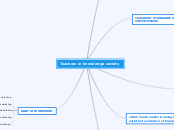Teachers in knowledge society
The internet is one of the greatest breakthroughs ever. With it, the whole world has turned into a global village, as now we have the means to communicate with a lot of people, from anywhere in the world. Additionally with the internet, we can watch videos, listen to music, use blogs, social media, download movies and books, so why not use it for educational purposes? But in order to do that everybody involved in the scholar community must be knowledgeable about ICT.
TEACHERS' STANDARDS AND COMPETENCES
TEACHERS' QUALITIES WITH ICT MASTERY
PEDAGOGICAL DIMENSION (ENHANCES STUDENTS' LEARNING EXPERIENCES)
INSTRUMENTAL, TECHNICAL DIMENSION (MASTERY OF AVAILABLE TECHNOLOGIES)
MANAGEMENT DIMENSION (THE USE OF ICT FOR AN IMPROVED CURRICULAR MANAGEMENT)
SOCIAL, ETHICAL, AND LEGAL DIMENSION (THE USE OF ICT FOR SOCIAL INCLUSION, ETHICAL AND LEGAL PURPOSES)
PROFESSIONAL DEVELOPMENT AND RESPONSIBILITY DIMENSION (THE USE OF ICT, FOR MORE EFFECTIVE AND UPDATED STUDENTS' LEARNING AND RESPONSIBILITY FOR THE CONTINUOUS PROFESSIONAL DEVELOPMENT)
DIMENSIONS
PEDAGOGICAL
GOAL: INTEGRATE ICT INTO THE TEACHING EXPERIENCE, TO ENHANCE STUDENTS' DEVELOPMENT.
TECHNICAL
GOAL: GUIDE THE PROCESS OF MODERN SYSTEMS AS WELL AS THE USE OF TOOLS.
MANAGEMENT
GOAL: STRENGTHEN AND DEVELOP STUDENTS' LEARNING PROCESS.
SOCIAL, ETHICAL AND LEGAL.
GOAL: TEACH STUDENTS HOW TO INTEGRATE ICT IN A RESPECTFUL WAY TO OTHERS, TO THEMSELVES AND TO THE ENVIRONMENT.
PROFESSIONAL, RESPONSIBILITY AND DEVELOPMENT
GOAL: MAKE SURE TO ACQUIRE THE COMPETENCES NEEDED SO THAT STUDENTS ACCOMPLISH THE LEARNING OBJECTIVES.
A GOOD TEACHER'S QUALITIES
PATIENT
CREATIVE
ADAPTABLE
GUIDE
LEADER
1992: Teachers ICT training begins, with the foundation of Enlaces.
ENLACES
ICT SIMCE
MEASURES STUDENTS' SKILLS WITH TECHNOLOGY
IDDE
ÍNDICE DE DESARROLLO DIGITAL ESCOLAR
ICT
INFORMATION AND COMMUNICATION TECHNOLOGY
ICT SKILLS GUIDELINE FOR LEARNING
DIMENSION
INFORMATION
INFORMATION AS A SOURCE (GOOGLING, CHOOSING INFORMATION, ORGANIZING)
EXAMPLE: 2o medio: Students define the source to be used (in. Digital encyclopedia,
specific search engine or website).
INFORMATION AS A PRODUCT (WHAT STUDENTS CAN DO WITH THE INFO, LIKE SUMMARIZE IT, SHARE IT, EXPOSE IT ETC)
Example: 6o básico: Students use concept mapping software to summarize information.
EFFECTIVE COMMUNICATION AND COLLABORATION
EFFECTIVE COMMUNICATION (RELAYING AND SHARING STUDENTS' END RESULTS, IN AN EFFECTIVE WAY)
Example: 6o básico: Students ecognize the importance of following grammar and spelling rules when creating a message when a homework emailed to the teacher.
COLLABORATION (PEERS' TEAMWORK FROM LONG DISTANCE)
Example: 2o medio: Students express themselves with respect towards their peers when exchanging opinions and comments on a chat in an educational context.
DIGITAL COEXISTENCE
ETHICS AND SELFCARE (STUDENTS PICK OUT WHAT INFO TO USE AND WHAT NOT)
Example: 6o básico: Students understand the risks of sharing personal information on digital media.
ICT AND SOCIETY (STUDENTS' ABILITY TO BREAK DOWN AND COMPREHEND THE SIGNIFICANCE OF ICT, IN CULTURAL, ECONOMIC, AND SOCIAL ISSUES)
Example: 2o medio: Students demonstrate detailed knowledge of ICT usage in areas such as work, politics, economy, social life, etc.
TECHNOLOGY
ICT KNOWLEDGE (THE ABILITY TO KNOW HOW TO USE A COMPUTER, SOFTWARE, AND HOW TO SOLVE BASIC PROBLEMS)
Example: 6o básico: Students describe the difference between hardware and software.
ICT OPERATION (RESPONSIBLE AND SAFE USE OF ICT, HOW TO ADMINISTER INFORMATION AND FILES)
Example: 2o medio: Students do not download illegal software.
ICT USE (STUDENTS' SOFTWARE AND HARDWARE MASTERY)
Example: 6o básico: Students know how to install and uninstall software.
DIGITAL WORKSHOP:
Robotic workshop
Video games workshop
Technological brigade workshop
Video edition workshop
Comic workshop
